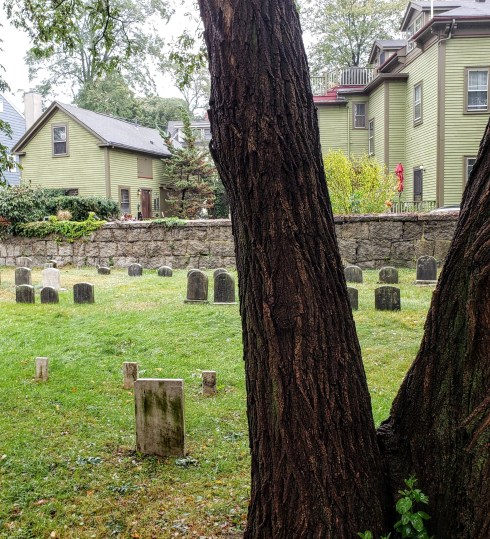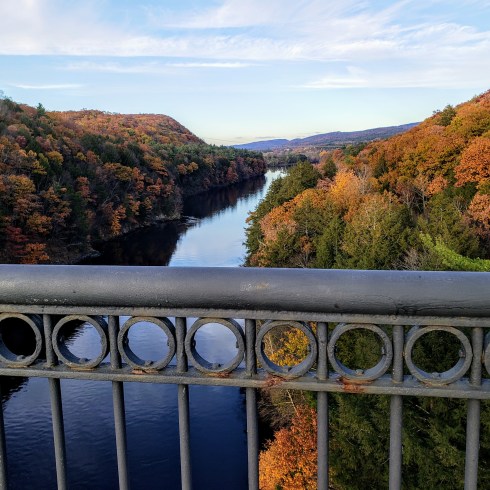I would really love to buy the toleration rationale that is used almost universally to justify Salem’s exploitation of the 1692 Witch Trials for commercial gain, but I have several issues. The argument goes like this: yes, we had a terrible tragedy here in 1692, but now we owe it to civilization to spread awareness of the intolerance of that community in order to raise awareness of intolerance in our own time. If we can make money at the same time, so be it, but it’s really all about teaching tolerance. I’ve written about this before, several times, so I’m not going to belabor the point, but I think this rationale reinforces a notion among some—actually many—that the victims of 1692 were doing something that was in some way aberrant or diverse, when in fact they were just plain old pious Protestants like their neighbors and accusers. The focus on toleration is supposed to connect the past to the present, but more than anything, it privileges the present over the past. My other problem with the toleration rationale is the exclusivity of its application: only to the Witch Trials, the intolerant episode with the most income-generating potential. We seldom hear of any other moments of intense intolerance in Salem’s history: the fining, whipping, and banishment of separatists, Baptists and Quakers in the seventeenth century, the anti-Catholicism and nativism of two centuries later. Certainly the Witch Trials were dramatic, but so too was the intense persecution in Massachusetts in general and Salem in particular over a slightly longer period, from 1656-1661: just read the title pages of these two incredibly influential texts which documented it.


Edward Burrough, A Declaration of the Sad and Great Persecution and Martyrdom of the People of God, called Quakers, in New England, for the Worshiping of God (1661; Christie’s —-the whole text can be found here); George Bishop, New England judged, not by man’s, but the spirit of the Lord: and the sum sealed up of New-England’s persecutions being a brief relation of the sufferings of the people called Quakers in those parts of America from the beginning of the fifth month 1656 (the time of their first arrival at Boston from England) to the later end of the tenth month, 1660 (1661; Doyle’s—the whole text is here).
The whipping, scourging, ear-cutting, hand-burning, tongue-boring, fining, imprisonment, starvation, banishment, execution, and attempted sale into slavery of Massachusetts Quakers by the colonial authorities is documented in almost-journalistic style by Edward Burrough and George Bishop and the former’s audience with a newly-restored King Charles II in 1661 resulted in a royal cease and desist missive carried straight to Governor Endicott by Salem’s own Samuel Shattuck, exiled Quaker and father of the Samuel Shattuck who would testify against Bridget Bishop in 1692. So yes, the Quakers accused the Puritans of intolerance far ahead of anyone else, and their detailed testimony offers many opportunities to explore an emerging conception of toleration in historical perspective: we don’t have to judge because they do. Every once in a while, an historical or genealogical initiative sheds some light on Salem’s Quakers—indeed, the Quaker Burying Ground on Essex Street was adorned by a lovely sign this very summer by the City, capping off some important restoration work on some of the stones—but their story is not the official/public/commercial Salem story: that’s all about “witches”.






Much of Salem’s Quaker history is still around us: the Essex Institute reconstructed the first Quaker Meeting House in 1865 and it is still on the grounds of the PEM’s Essex Street campus (Boston Public Library photograph via Digital Commonwealth); the c. 1832 meeting house formerly at the corner of Warren and South Pine Streets, Frank Cousins photograph from the Phillips Library Collection at Digital Commonwealth; the c. 1847 meeting house–now a dentist’s office overlooking the Friends’ Cemetery on upper Essex Street; Samuel Shattuck’s grave in the Charter Street Cemetery, Frank Cousins, c. 1890s, Phillips Library Collection at Digital Commonwealth.
Quakers can’t compete with “witches”, any more than factory workers, soldiers, inventors, poets, suffragists, educators, or statesmen or -women can: they’re just not sexy enough for a city whose “history” is primarily for sale. There was a time when I thought we could get the Bewitched statue out of Town House Square, but no more: it will certainly not be replaced by a Salem equivalent of the Boston memorial to Mary Dyer, one of the Boston Quaker “Martyrs”. The placement of a fictional television character in such a central place—just across from Salem’s original meeting house–and not, say, a memorial to Provided Southwick, whose parents were banished to Long Island, dying there in “privation and misery”, whose brother was whipped from town to town, and who would have been sold into slavery (along with another brother) near this same square if not for several tolerant Salem ship captains*, is a bit unbearable, but that’s Witch City. Apparently grass just won’t grow in this little sad space, so soon we will see the installation of artificial turf , which strikes me as completely appropriate.



“The Attempted Sale into Slavery of Daniel and Provided Southwick, son [children] of Lawrence and Cassandra Southwick, by Governor Endicott and his Minions, for being Quakers”, from the Genealogy of the descendants of Lawrence and Cassandra Southwick of Salem, Mass. : the original emigrants, and the ancestors of the families who have since borne his name (1881); *John Greenleaf Whittier tells Provided’s tale under Cassandra’s (more romantic?) name, and adds the “tolerant ship captains”: we only know that the sale did not go through. The Mary Dyer Memorial in front of the statehouse, Boston, Massachusetts.
Appendix: There was a very public attempt to place a memorial statue to the Quaker persecution in Salem by millionaire Fred. C. Ayer, a Southwick descendant, in the early twentieth century which you can read about here and here: the Salem City Council (or Board of Aldermen, as it was then called) objected to the representation of Governor Endicott as a tiger devouring the Quakers, so the proposed installation on Salem Common was denied. If the aldermen had read Burrough’s and Bishop’s accounts, I bet they would have been a bit more approving.
Like this:
Like Loading...




 Frederick Kemmelmeyer’s portrait of Luther, National Gallery of Art+the carved pumpkins on my neighbor’s front stoop; Frederick the Wise’s Dream and the beginning of the Reformation, October 31, 1517, Library of Congress; Cranach’s Schlosskirche in Wittenberg; the viral meme that inspired me: 95 Reeses!
Frederick Kemmelmeyer’s portrait of Luther, National Gallery of Art+the carved pumpkins on my neighbor’s front stoop; Frederick the Wise’s Dream and the beginning of the Reformation, October 31, 1517, Library of Congress; Cranach’s Schlosskirche in Wittenberg; the viral meme that inspired me: 95 Reeses!











 A dreamy house—and former tavern—in Montague Center: listing
A dreamy house—and former tavern—in Montague Center: listing 








 All around Montague Center: house & barns, the Book Mill, Valley cats, Viennese heirlooms, the Homestead.
All around Montague Center: house & barns, the Book Mill, Valley cats, Viennese heirlooms, the Homestead.


 Turners Falls, 1877, Digital Commonwealth ( I don’t think all of those streets were filled out!); the fast-flowing river after the Falls; workers’ housing. On the way home, the French King Bridge over the Connecticut River.
Turners Falls, 1877, Digital Commonwealth ( I don’t think all of those streets were filled out!); the fast-flowing river after the Falls; workers’ housing. On the way home, the French King Bridge over the Connecticut River.

 1931 Cheshire House edition with illustrations by Abner Epstein; 1950 British film version.
1931 Cheshire House edition with illustrations by Abner Epstein; 1950 British film version.




 The house exterior in the 1928 American film, the 1950 British Film, and the 1960 Roger Corman film; Jean Epstein’s 1928 film prefers to focus on its baronial interior.
The house exterior in the 1928 American film, the 1950 British Film, and the 1960 Roger Corman film; Jean Epstein’s 1928 film prefers to focus on its baronial interior.


 The House: illustrations by Robert Swain Gifford (1884); Daniel Walper (1922), Albert Dubout (1948), Arthur Rackham (1935) and Gris Grimly (2004).
The House: illustrations by Robert Swain Gifford (1884); Daniel Walper (1922), Albert Dubout (1948), Arthur Rackham (1935) and Gris Grimly (2004). Confronting a GEORGIAN haunted house: The Little Stranger (2018). Talk about a house-centered story! In both the film and the book, the house is a MAJOR character, even more so than in Usher. The juxtaposition of the airy (though decayed) Georgian and the “presence” heightens the tension, and you realize that possession has multiple meanings.
Confronting a GEORGIAN haunted house: The Little Stranger (2018). Talk about a house-centered story! In both the film and the book, the house is a MAJOR character, even more so than in Usher. The juxtaposition of the airy (though decayed) Georgian and the “presence” heightens the tension, and you realize that possession has multiple meanings.





















 The Old Burying Point on Charter Street is closed (thankfully) all month long; if you do come during the week you can ride a scooter around town—but not on the weekend as they have been banned because of the crowds.
The Old Burying Point on Charter Street is closed (thankfully) all month long; if you do come during the week you can ride a scooter around town—but not on the weekend as they have been banned because of the crowds.





















 The names of just one day’s (September 22) victims of the Salem Witch Trials reveal some extent of the regional impact, but the University of Virginia’s site has a dynamic regional map
The names of just one day’s (September 22) victims of the Salem Witch Trials reveal some extent of the regional impact, but the University of Virginia’s site has a dynamic regional map 


 I can’t find a single contemporary (or later) image of Saltonstall–only mistaken images of his grandfather and son, but Sidney Perley included his autograph in his History of Salem (1924); Saltonstall family crest, Cowan’s Auctions.
I can’t find a single contemporary (or later) image of Saltonstall–only mistaken images of his grandfather and son, but Sidney Perley included his autograph in his History of Salem (1924); Saltonstall family crest, Cowan’s Auctions.
 You can read the entire first edition of the Daemonologie of King James by “turning the pages” at the British Library
You can read the entire first edition of the Daemonologie of King James by “turning the pages” at the British Library  British Library version
British Library version 


 The (official) Witchfinder General in Salem, September 30, 2019.
The (official) Witchfinder General in Salem, September 30, 2019.


